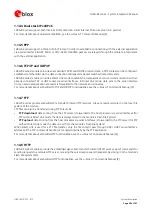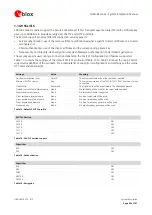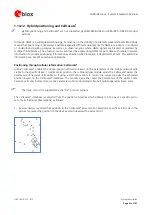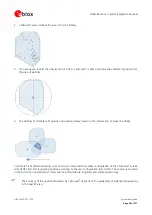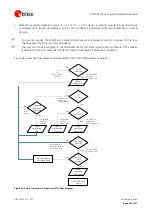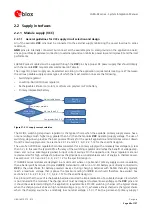
LARA-R2 series - System Integration Manual
UBX-16010573 - R12
Design-in
Page 69 of 157
charging source (e.g. ~12 V) and a rechargeable back-up battery (e.g. 3.7 V Li-Pol) are available at the same time
as a possible supply source, then a proper charger / regulator with integrated power path management function
can be selected to supply the module while simultaneously and independently charging the battery. See sections
2.2.1.8, 2.2.1.9, and 2.2.1.4, 2.2.1.6, 2.2.1.7, 0, 2.2.1.12 for the specific design-in.
An appropriate primary (not rechargeable) battery can be selected taking into account the maximum current
specified in the
LARA-R2 series Data Sheet
[1] during connected mode, considering that primary cells might have
weak power capability. See sections 2.2.1.5, 2.2.1.6, 0, and 2.2.1.12 for the specific design-in.
The usage of more than one DC supply at the same time should be carefully evaluated: depending on the supply
source characteristics, different DC supply systems can turn out as being mutually exclusive.
The usage of a regulator or a battery not able to support the highest peak of
VCC
current consumption specified
in the
LARA-R2 series
[1] is generally not recommended. However, if the selected regulator or battery
is not able to support the highest peak current of the module, it must be able to support at least the highest
averaged current consumption value specified in the
LARA-R2 series
[1] with an adequate margin. The
additional energy required by the module during a 2G Tx slot can be provided by an appropriate bypass tank
capacitor or super-capacitor with very large capacitance and very low ESR placed close to the module
VCC
pins.
Depending on the actual capability of the selected regulator or battery, the required capacitance can be
considerably larger than 1 mF and the required ESR can be in the range of few tens of m
. Carefully evaluate the
super-capacitor characteristics, since aging and temperature may affect the actual characteristics.
The following sections highlight some design aspects for each of the supplies listed above, providing application
circuit design-in compliant with the module
VCC
requirements summarized in Table 6.
2.2.1.2
Guidelines for VCC supply circuit design using a switching regulator
The use of a switching regulator is suggested when the difference from the available supply rail to the
VCC
value
is high: switching regulators provide good efficiency transforming a 12 V or greater voltage supply to the typical
3.8 V value of the
VCC
supply.
The characteristics of the switching regulator connected to the
VCC
pins should meet the following prerequisites
to comply with the module’s
VCC
requirements summarized in Table 6:
Power capability
: the switching regulator with its output circuit must be capable of providing a voltage value
to the
VCC
pins within the specified operating range and must be capable of delivering to the
VCC
pins the
specified maximum peak / pulse current consumption during Tx burst at the maximum Tx power specified in
the
LARA-R2 series
Low output ripple
: the switching regulator together with its output circuit must be capable of providing a
clean (low noise)
VCC
voltage profile.
High switching frequency:
for best performance and for smaller applications, it is recommended to select
a switching frequency
≥
600 kHz (since the L-C output filter is typically smaller for high switching frequencies).
The use of a switching regulator with a variable switching frequency or with a switching frequency lower than
600 kHz must be evaluated carefully, since this can produce noise in the
VCC
voltage profile and therefore
negatively impact modulation spectrum performance.
PWM mode operation
: it is preferable to select regulators with a Pulse Width Modulation (PWM) mode.
While in connected mode, the Pulse Frequency Modulation (PFM) mode and PFM/PWM modes transitions
must be avoided in order to reduce noise on the
VCC
voltage profile. Switching regulators can be used that
are able to switch between low ripple PWM mode and high ripple PFM mode, provided that the mode
transition occurs when the module changes status from the idle/active modes to connected mode. It is
permissible to use a regulator that switches from the PWM mode to the burst or PFM mode at an appropriate
current threshold.
Output voltage slope
: the use of the soft start function provided by some voltage regulators should be
evaluated carefully, as the
VCC
voltage must ramp from 2.3 V to 2.8 V in less than 4 ms to switch on the
module by applying the
VCC
supply. The module can be otherwise switched on by forcing a low level on the
RESET_N
pin during the
VCC
rising edge and then releasing the
RESET_N
pin when the
VCC
supply voltage
stabilizes at its proper nominal value.




